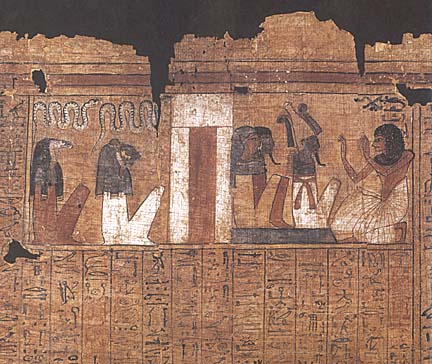Advertisement - Click to support our sponsors.


No denial: Hollywood
By Tim Ryan
added to the mystique
and intrigue
Star-BulletinTHERE are several fallacies and fables about ancient Egypt that may have provided Hollywood fodder for films and had viewers squirming in their seats but few are true.
Despite dozens of mummy films about these ghoulish corpses seeking revenge after being disturbed, "Mummies don't walk, ever," joked Karen Thompson, curator of education at the Honolulu Academy of Arts.
Yes, the pyramids are huge, but the chambers within are "incredibly small and empty," Thompson said.
"Visitors are often surprised at how small the rooms actually are compared to the size of the pyramids," she said.
There's also no proof, despite what happens in the classic film "Land of the Pharaohs," that people who worked building the inner chambers of the pyramid automatically were condemned to death because they knew the secret routes to the burial and treasure chambers, Thompson said. Also, enemies were not thrown into pits filled with starving crocodiles, although the Nile River did have crocs -- and hippos too, she said.
In the 26th century B.C., as Egyptian civilization was reaching its height, three kings, Khufu, his son Khafre, and his grandson Menkure ordered the construction of three huge pyramids that would serve as their tombs. The first of these, the Great Pyramid, is the largest ever built.
It stands with the other two pyramids and the Great Sphinx in a cluster near the town of Giza.
King Khufu's pyramid rests on a base that covers 13 acres, and each side of the base is about 756 feet long. The Great Pyramid once rose to a height of 481 feet, but the top now has been stripped.
Burial chambers were placed under the centers of the pyramids and passageways to the chambers were later sealed with heavy stones. Hollywood got that one right.
As many as 100,000 men labored for 20 years to complete the Great Pyramid using some 2.3 million stone blocks. Pyramid builders weren't slaves as depicted on film, but conscripted workers who received compensation -- usually supplies and food -- for their work.
As for the most famous sphinx -- the one near the pyramid of Khafre at Giza, about six miles from Cairo -- it was built to guard the pyramid, and later worshiped as the god Ra-horakhty, "Ra of the Two Horizons." The misshapen face -- a combination of a beast's body, usually a lion's, with the human face of the ruling pharaoh -- is not only a result of erosion. Napoleon's soldiers once used the Sphinx's nose for target practice.
Cleopatra VII, queen of Egypt, 69 to 30 B.C., is one of the most fascinating women of all time. But she was not Egyptian. She was Greek.
Did you know that:
Cleopatra did commit suicide the old fashion Egyptian way: she let herself be bitten "by a poisonous asp," Thompson said.
Tutankhamen was only about 18 years old when he died. He owes his place in history mostly to the discovery of his tomb completely intact, including a beautiful golden mask.
Nefertiti, the queen-consort of the controversial Egyptian king Akhenaten of the 18th dynasty, is famous for the bust of her head, made of painted limestone.
Now here's the simple stuff:
Upper Egypt is in the south; Lower Egypt is in the north.
The main staples in ancient Egypt were bread and beer. The average Egyptian consumed 3-1/2 liters of beer a day.
Egyptians had bad teeth because they ate so much bread -- there were 50 varieties. The flour for the bread was ground on stones and so much of the stone wound up in the bread that it wore down their teeth!
There is no Egyptian "art." There's no word for art in the language. No artists ever signed their work, and most of the work was recorded as group projects.
The pharaoh is always shown in a dignified pose, never in movement. Sculptors painted the bodies of men red and women pale yellow and set colored stones or crystals as eyeballs.
Click for online
calendars and events.